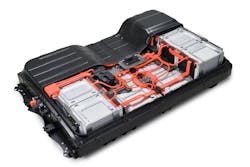BNEF: Lithium-ion Battery Pack Prices Falling, but Commodity Pressures may Inflate them in 2022
By Rod Walton, EnergyTech Senior Editor
Those confidently awaiting the mass market conversion to electric vehicles got some good pricing news once again this week, but check out the warning light—other supply chain issues are putting upward pressure on EV economics that may take years to iron out.
A new report by BNEF (Bloomberg New Energy Finance) indicates that lithium-ion battery packs fell to $132 per kWh this year, a six percent drop from 2020 and 90 percent less what they were in 2010 ($1,200/kWh). This decade-plus trend bodes well for future EV battery price competitiveness, if not tackling other nagging issues with the general car customer base such as range fear and charging infrastructure concerns.
The Bloomberg report was not just about EV batteries, but all of those li-ion packs used for EVs, electric buses and stationary storage projects. Specifically, though, EV-related li-ion battery packs dropped to $118 per kWh.
Unfortunately, we live in a new era of inflation not seen for decades. Thus, rising prices on other commodities and supply chain constrictions in the COVID era are offsetting the falling prices for batteries used in all of those applications.
BNEF’s Battery Price Survey predicted that the average pack price would fall below $100 per kWh by 2024, making it competitive for automakers to produce and sell mass-market EVs vs. internal combustion vehicles in some markets. In the near term, however, these inflationary pressures could push the average li-ion battery pack price back up to $135/kWh next year.
“We estimate that on average price of an NMC (811) cell is $10 per kWh higher in the fourth quarter than it was in the first three months of year,” James Frith, BNEF’s head of energy research and lead author of the report, said in the summary. “This creates a tough environment for automakers, particularly those in Europe, which have to increase EV sales in order to meet average fleet emissions standards."
“These automakers may not have to make a choice between reducing their margins or passing costs on—at the risk of putting consumers off purchasing an EV,” he added.
This inflationary trend could push the pivotal $100/kWh threshold back by two years to 2026, according to BNEF. This could impact EV affordability, as Frith noted, and hurt the economics of utility-scale or distribution level energy storage projects.
-- -- --
(Rod Walton, senior editor for EnergyTech, is a 14-year veteran of covering the energy industry both as a newspaper and trade journalist. He can reached at [email protected]).
About the Author
EnergyTech Staff
Rod Walton is senior editor for EnergyTech.com. He has spent 17 years covering the energy industry as a newspaper and trade journalist.
Walton formerly was energy writer and business editor at the Tulsa World. Later, he spent six years covering the electricity power sector for Pennwell and Clarion Events. He joined Endeavor and EnergyTech in November 2021.
He can be reached at [email protected].
EnergyTech is focused on the mission critical and large-scale energy users and their sustainability and resiliency goals. These include the commercial and industrial sectors, as well as the military, universities, data centers and microgrids.
Many large-scale energy users such as Fortune 500 companies, and mission-critical users such as military bases, universities, healthcare facilities, public safety and data centers, shifting their energy priorities to reach net-zero carbon goals within the coming decades. These include plans for renewable energy power purchase agreements, but also on-site resiliency projects such as microgrids, combined heat and power, rooftop solar, energy storage, digitalization and building efficiency upgrades.
